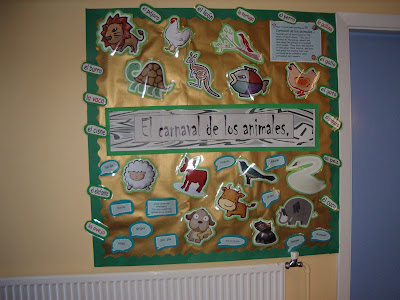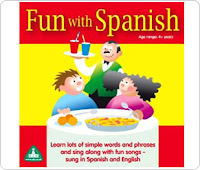
Here’s the second of four posts on the Spanish QCA units I’m using with KS2 this term. The first, QCA Unit 5, Los Cuatro amigos seemed to be popular so I hope you find this one helpful too.
First thing to say is that I really enjoyed teaching this unit – and the class seemed to be equally enthused. The combination of music, literacy and Spanish proved popular, and this half term the cross curricular element is extended as habitats is a topic in Science. And I was really pleased with the outcomes of the unit.
You can download the Unit in PDF or RTF from the QCA website.
Below is my medium term plans – being adapted as I go along and discover what does and doesn’t work.
Medium term planning QCA Unit11 El Carnaval del os Animales
Unit 11 is based around and inspired by the Saint Saens piece, Le carnaval des animaux, and the opening lesson was heavily reliant on music. I borrowed the CD of The carnival of the animals from the library, but then found a great website that provided snippets for each animal theme. The site being in Spanish with short comments on the music makes it a possible resource for more experienced linguists to use in the discussion of music in Spanish rather than the English we used for ours. And it’s a gift for the teacher who can point the pupils in the right direction if they’re struggling.
We began by looking at the title of the Unit. I asked pupils to suggest what they might be learning in this topic, encouraging them to explain their ideas e.g. it’s something about animals I think – the last word looks like animals; ‘carnaval’ looks like carnival etc. None of the class made the association with the piece of music as none had heard of it. Having established the title, I asked them to suggest what sorts of things they might learn – they’re good at this as AfL is a focus this year at WCPS. Lots of suggestions hit the mark and others would’ve been good avenues for exploration given more time.
Then we listened to snippets of the music, in order, and I asked for suggestions as to the animal it represented. As I’ve already mentioned, this was done in English and was much more successful than I had thought it might be. As my lesson allocation for the class covered their music lesson too, we were able to spend more time on Spanish by combining the two lessons. The music topic was based on rhythm and this fitted well. The pupils love contemporary music but it was good to see and hear them discussing a classical piece and passing positive comment. The suggestions of animals were sometimes accurate but some were off mark and this was probably due to not being given an idea of the animals we might be considering, so this half term when I did the same lesson with the other class, I began the same but introduced the vocabulary in Spanish prior to playing the music. This allowed more accurate identification of animals and moved us onto discussion of how the animal was represented / suggested by the music much more immediately. I introduced the animals using the PPT below, accompanied by actions e.g un león was two hands like paws ready to pounce; un gallo, one hand on top of head, one under chin with wiggling fingers like the comb and crop; un elefante with your arm as a trunk etc. Using images and actions we played Beat the teacher, ¿Dónde está …? Simon dice, name the animal from the action and viceversa, to reinforce the vocabulary.
El Carnaval de los animales
The second lesson began with a video of Los pollitos dicen..,I’d downloaded it from Youtube which was fortunate as Youtube is now blocked at school.
We watched a number of times and pupils began to join in with the opening lines as they wanted. Having looked at the video, I challenged the pupils once more to think about one of the objectives for the lesson. Several suggestions were made including habitat, food, mummies and babies, and, the correct answer, animal noises.
We recapped the animal vocabulary using actions, images and also rhythm. As we repeated the words, I clapped the rhythm. Pupils echoed the clap back again and we played games around the rhythm of the words. More of that later..
Moving on, we listened to a number of animal noises and asked the pupils to make educated guesses on the animal that made each noise, commenting on similarities and
differences. We made a great cacophony of animal noises, akin to an unruly zoo as we practiced Spanish animal noises – the class were very amused that Spanish animals spoke another language too! With the noises came additional animals, extending beyond the initial stimulus. Below is a consolidation worksheet that we used to round off the section of the lesson as well as the PPT I used.
Los sonidos de los animales
Worksheet lesson 2 Unit 11
After the lunch break, we decided to make an animal symphony using percussion and voice! This met the objectives of the music unit as well as suggested activities in the QCA guidelines for the Spanish unit. Pairs of pupils were given an animal picture and a percussion instrument to create firstly a sound effect for their animal, and then used it to beat the rhythm of the word in Spanish. we took this further by individually presenting our pieces and then joining them together with teacher in the role of conductor bringing in and cueing out animals. The resulting ‘symphony’ was very interesting and you can listen to it here on our podcast WCPS Spanish (sounded better live, I must add!) A very enjoyable activity and an excellent for trying to maintain a steady rhythm and stay in time with others!
The next lesson was based around time and concluded with a class full of hot sweaty children and two children in first aid! Having recapped numbers 1-12 using a soft ball and various games – always a winner when I start chucking things around the room as I am hopeless at hand-eye coordination – I used an ELC clock to model the time for one and two o’clock before several bright sparks took over for three o’clock, half the class for four o’clock and 28/30 by five o’clock. We played time bingo and completed some questions from the IWB (sadly can’t save those in Doc.Stoc so will have to put them in My Box of Goodies)
With o’clock times stuck in our heads and consolidated with a written exercise, I ventured to suggest we could go out onto the playground and play a game. This was a popular idea – although not so popular when the class discovered that there were three other classes outside and they weren’t working, just running around. However, to their credit, they mostly concentrated and several children from other classes came to see what we were doing! We played ¿Qué hora es, Señor Elefante? , a variant on What’s the time Mr Wolf in which the animal changes each time, and the players have to move like the animal named e.g like an elephant for Sr. Elefante, like a swan for Sra. Cisne etc for the number of steps that corresponds to the time. More practice needed on the movement – never seen a tortoise run, nor a fish! However, lots of volunteers to be ‘on’. We also played El Carnaval de los animales, very like fruit salad but with animals instead of fruit. Having given each child the name of one of six animals in Spanish, I called an animal and all those with that name had to move around the outside of the circle back to their space in the manner of their animal. If I called El Carnaval de los Animales, everyone had to move around the circle like their animal. This was the cause of the scrapped knees in first aid I’m afraid :o( but the injured parties weren’t too sad so it was OK (phew!)
Next we looked at adjectives. Pupils had already commented on the colours of the nouns on their wordlist (see initial PPT) and had met colours in a previous unit. Some recalled the need for agreement and noted why there were two versions of most adjectives.
I used Querido Zoo (Dear Zoo) as the stimulus for the lesson – a familiar story to many and again introducing another couple of animals for those who had already grasped the others as well as great for introducing adjectives describing animals, and the word for ‘too’ – demasiado. Having read the book on PPT, pupils made their own conclusions in groups about the meaning of the adjectives before we discussed (and corrected!) ideas together. Having introduced a few more ideas including rápido / lento, fuerte/débil etc, pupils made up some sentences using es and no es to describe animals. This turned into a guessing game with definitions being offered and others trying to guess the animal, and there was also a pleasing clamour to find out more adjectives using a dictionary – cue impromptu lesson in bilingual dictionary skills!
Habitats came into play next – using the suggested habitats from the QCA unit in a IWB flipchart (again, will have to put it into My Goodie Box!) we looked at pictures and guessed the theme of the lesson before placing animal cards into the appropriate habitat, making statements about where the animals lived. We used the first person, pretending that we were the animal preparing for the written part of the lesson when pupils took the role of an animal to be interviewed. We reviewed personal identification questions and modelled a couple of examples on the IWB before pupils went away to produce their own introductions.
4AT had heard that 5MW had been recording and they wanted in on the act. So we set up our recording studio in a corner and several pupils came to record their work for WCPS Spanish, our podcast. It was great to see all abilities represented in the volunteers, including all SEN pupils, and there were some who were reluctant to go to lunch as they hadn’t had a chance to record. In fact, we even moved the studio to the library during their librar
y session to allow more participation. Great to see them so motivated.
I actually had an extra lesson with the class and decided to continue on the animal theme! We looked at the Build my WildSelf site and discussed the different animals and body parts included (this recapped vocabulary learned in year 3) Having designed their own Wild Self (a very amusing task attacked with great gusto), pupils designed their own hybrid animals on paper and wrote simple sentences about them such as;
Tiene la cabeza de un elefante.
Tiene el cuerpo de un pez. 
Tiene la cola de un lagarto.
Tiene las piernas de una jirafa.
I made a display as part of the Unit too, well received by all of KS2 including the staff who liked its vibrant images and interactive quality – all the stuff to make it below! Just laminate! You can see more of the display here .
display
Since completing the Unit, I’ve discovered the following resources
Again, hope you found this useful.
Next I’ll report on Unit 14 Yo soy músico – that was a goody too :o)







